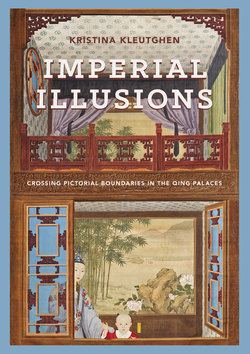Читать книгу Imperial Illusions - Kristina Kleutghen - Страница 88
На сайте Литреса книга снята с продажи.
Оглавление2.9Diagram for creating objects using distance-point perspective. From Nian Xiyao, The Study of Vision. The Bodleian Libraries, University of Oxford, Douce Chin. B. 2, p. 49v.
Section 7 (50v–53r) explains how to produce illusionistic ceiling paintings, beginning with an image marking out the walls and ceiling of a room (not shown) and progressing through several complicated schematic preparatory illustrations. These are accompanied by the longest instructional passages in the entire treatise, together depicting and describing how to foreshorten the columns and windows so as to appear to be receding vertically away from a viewer standing on the ground and looking up. This sequence results in two finished examples (figure 2.10): a round cupola open to the sky and a square cupola closed at the top, both punctuated by latticed windows and columns around their sides. Like those in the opening section of the treatise, these images are borrowed from the Perspectiva. The false dome or cupola was one of Andrea Pozzo’s trademark forms, repeated in the printed treatise, which spread knowledge of the examples he painted in Sant’Ignazio as well as in Vienna’s Jesuit church. Nian’s illustrations therefore depict the appearance of a vertical extension of space above a flat ceiling, known in the European context as di
